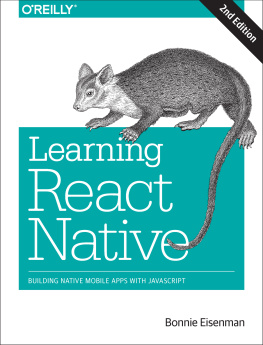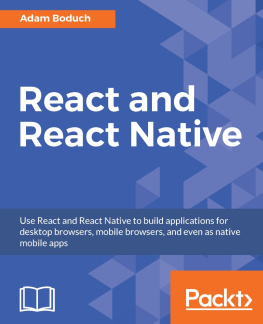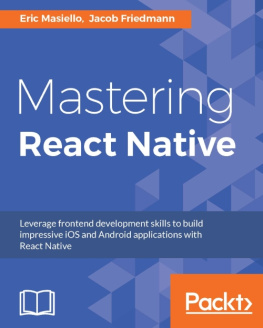Sagar Ganatra [Sagar Ganatra] - React Router Quick Start Guide: Routing in React Applications Made Easy
Here you can read online Sagar Ganatra [Sagar Ganatra] - React Router Quick Start Guide: Routing in React Applications Made Easy full text of the book (entire story) in english for free. Download pdf and epub, get meaning, cover and reviews about this ebook. year: 2018, publisher: Packt Publishing, genre: Computer. Description of the work, (preface) as well as reviews are available. Best literature library LitArk.com created for fans of good reading and offers a wide selection of genres:
Romance novel
Science fiction
Adventure
Detective
Science
History
Home and family
Prose
Art
Politics
Computer
Non-fiction
Religion
Business
Children
Humor
Choose a favorite category and find really read worthwhile books. Enjoy immersion in the world of imagination, feel the emotions of the characters or learn something new for yourself, make an fascinating discovery.
- Book:React Router Quick Start Guide: Routing in React Applications Made Easy
- Author:
- Publisher:Packt Publishing
- Genre:
- Year:2018
- Rating:4 / 5
- Favourites:Add to favourites
- Your mark:
React Router Quick Start Guide: Routing in React Applications Made Easy: summary, description and annotation
We offer to read an annotation, description, summary or preface (depends on what the author of the book "React Router Quick Start Guide: Routing in React Applications Made Easy" wrote himself). If you haven't found the necessary information about the book — write in the comments, we will try to find it.
Learn how you can implement routing in a React Web/Native application using React-Router library
Key Features- Create nested routes and complex workflows for your applications
- Learn Routing in server-side rendered applications and in Native mobile applications
- Understand how Redux bindings for React-Router works using the connected-react-router library
React Router is the routing library for React, and it can be used in both React Web and React Native applications. This book is a simple way to get started with React Router and harness its full power for your applications.
The book starts with an introduction to React Router and teaches you how to create your first route using the React component. You will then learn about configuring your routes, passing parameters, and creating nested routes. You will be introduced to various components in React-Router and learn different configuration options available for these components. You will then see how to use the Redirect and Switch components. For even greater flexibility, you will learn about BrowserRouter, HashRouter, NativeRouter, and StaticRouter.
By the end of the book, you will have set up a project with React Router and make routing configuration work in a server-side rendered React application, a mobile application built with React Native and also understand how Redux and React-Router can be used in the same application.
What you will learn- Create your first Route using the Route component
- Protect routes from unauthorized access by using the redirect component
- Navigate to your defined route using Link and NavLink
- Configure BrowserRouter and HashRouter using various props
- Use StaticRouter for routing in server-side rendered React applications
- Implement routing in a React Native app using react-router-native
- Using connected-react-router library with React-Router for better state management
This book is for JavaScript developers who have basic knowledge of React and who want to harness the power and flexibility of React Router
Table of Contents- Introduction to React Router 4 and Creating Your First Route
- Configuring Routes - Using Various Options in the Route Component
- Using the Link and NavLink Components to Navigate to a Route
- Using the Redirect and Switch Components
- Understanding the Core Router, and Configuring the BrowserRouter and HashRouter components
- Using StaticRouter in a Server-Side Rendered React Application
- Using NativeRouter in a React Native Application
- Redux Bindings with connected-react-router
**
Sagar Ganatra [Sagar Ganatra]: author's other books
Who wrote React Router Quick Start Guide: Routing in React Applications Made Easy? Find out the surname, the name of the author of the book and a list of all author's works by series.

![Sagar Ganatra [Sagar Ganatra] React Router Quick Start Guide: Routing in React Applications Made Easy](/uploads/posts/book/119450/thumbs/sagar-ganatra-sagar-ganatra-react-router-quick.jpg)






![Azat Mardan [Azat Mardan] - React Quickly](/uploads/posts/book/119471/thumbs/azat-mardan-azat-mardan-react-quickly.jpg)
![Adam Boduch [Adam Boduch] - React and React Native - Second Edition](/uploads/posts/book/119457/thumbs/adam-boduch-adam-boduch-react-and-react-native.jpg)

